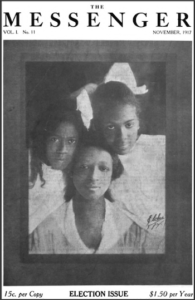
November 1917 issue
*In August 1917, the first issue of Messenger magazine was published. This was an early 20th-century political and literary magazine by and for African American people. It was important to the growth of the Harlem Renaissance and initially promoted a socialist political view. The Messenger was co-founded in New York City by Chandler Owen and A. Philip Randolph.
Toward the end of 1916, Randolph and Owen dropped out of college, joined the Socialist Party, and gave soapbox orations on street corners around Harlem. Their socialist and labor union propaganda gained them celebrity in the area. When they walked into the office building at 486 Lenox Avenue while looking for a meeting space for their Independent Political Council, they were recognized by William White, President of the Headwaiters and Sidewaiters Society of Greater New York. He suggested they move into his society's headquarters and edit a monthly magazine for waiters. From January until August 1917, Randolph and Owen published the Hotel Messenger. But their exposé of union corruption resulted in their immediate dismissal.
They moved into an office next door at 513 Lenox Avenue. With the patronage of Randolph's wife, Lucille, they launched The Messenger. The first issue cost 15 cents (its price would never change) and ran the mission statement written by Randolph and Owen. Declaring that "with us, economics and politics take precedence over music and art," the magazine's first two years were primarily devoted to advocating black labor unionism and socialism and denouncing the war and its effects on black Americans. The magazine attacked President Woodrow Wilson's call to make "the world safe for democracy" when the black community was at risk in the U.S. Since the late 19th century, it had suffered a high rate of lynchings and violence in the South.
The editors of the Messenger also criticized major northern Black figures such as W. E. B. Du Bois, who was pro-war then, and Marcus Garvey's theory of Black Nationalism, specifically his goal of re-populating the African continent solely with Blacks, and promoting the idea in the United States. After 1920, The Messenger featured more articles about black culture and began to publish rising black writers. It became a kind of literary magazine notable for helping strengthen African American intellectual and political identity in the age of Jim Crow. Through the 1920s, it also noted the success of blacks reaching the middle class in business and the professions, publishing a series of essays, "These 'Colored' United States," submitted by writers nationwide.
During the 1920s, Messenger also published a series of essays, "These 'Colored' United States", from January 1923 through September 1926. Articles were submitted by writers from across the nation, reporting on the rise of middle-class blacks in business and the professions. One such article reported on 28 successful men and women in business, the professions, teaching, crops produced by black farmers in Virginia, and other property held by them. The final issue of Messenger magazine was in 1928.